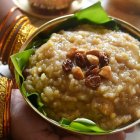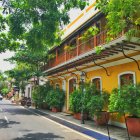Related articles
-
 Want to Pamper Your Taste-Buds this Pongal? Here are Mouth-Watering Pongal Recipes You can't Miss in 2019
Want to Pamper Your Taste-Buds this Pongal? Here are Mouth-Watering Pongal Recipes You can't Miss in 2019
-
 Diwali Snacks You Can Make in Your Kitchen, which Are As Healthy As They Are Delicious! (2021)
Diwali Snacks You Can Make in Your Kitchen, which Are As Healthy As They Are Delicious! (2021)
-
 Make Gifting Easy this Festive Season with a Gift Pack: 11 Awesome Ideas for Diwali Gift Packs for 2019
Make Gifting Easy this Festive Season with a Gift Pack: 11 Awesome Ideas for Diwali Gift Packs for 2019
4 Days of Pongal and Their Significance
The Bhogi Festival
India is a diverse country with different traditions and cultures. Pongal is one such festival which is celebrated in Tamil Nadu and is popularly called as the harvest festival as well. Pongal actually means to boil and it is basically celebrated as a thanksgiving to the year's new harvest.
The first day is called Bhogi festival and it is celebrated in the glory of Lord Indra who is considered as the god of rain. A ritual called Bhogi Mantalu is also practised on this day where useless items of the household are tossed in the fire. The fire is traditionally lit with the help of cow dung and wood logs.
Thai Pongal
This is the second day of the Pongal where a special ritual is performed. On this day, rice and milk are boiled together in an earthen pot. The earthen pot is decorated with mirrors and painted in different colours.
A turmeric plant is tied to the earthen pot and this whole ritual is performed by offering to the sun god. Sugarcane sticks, bananas and coconuts are also offered. The other important tradition of this day is called kolam.
Kolam is a traditional design which is drawn near the entrance of the houses with lime powder. The drawing should be done right in the morning after having a bath. Normally, young girls cook the rice during Pongal. They are all dressed up in their traditional attire.
Mattu Pongal
The third day is celebrated by adorning the cattle. Since it is a harvest festival, cattle play an important role during farming. On this day, the cattle are decorated with bells, garlands and sheaves of corn. After which, they are worshipped.
There is a mythological story behind this one as people say that Lord Shiva had once sent a bull called Basava on Earth. He asked him to give a message to the mortals asking them to take a bath and massage their body with oil. He also asked to eat once a month.
Basava got confused and asked the mortals to do the opposite. After which Shiva was furious and he banished Basava on Earth forever and cursed him to plough fields to help humans produce more food. Thus, this day is dedicated to cattle.
Kaanum Pongal
This is the last day of Pongal where a different ritual is performed. People put a washed turmeric leaf with betel leaves on their courtyard. On the leaves, they put leftovers of sweet Pongal, betel nuts, sugarcane and some more food.
This ritual is carried out by women of the house. They carry this ritual in the name of their brothers. They pray and ask for their brother's prosperity and happiness. It is carried out with a lot of spirit and joy by all the ladies.
Send Best Wishes to Your Relatives During Pongal
Pongal is a beautiful festival and has a great logic behind its rituals and celebrations. It is a form of thanksgiving to nature who blesses us with food. Thus, it is a good idea to send best wishes to all your friends and relatives.
You can send them a postcard instead of just sending them a digital greeting. Sending a postcard or seasons greeting card shows some effort and thus, the recipient will definitely appreciate it. The best part is that they can preserve and cherish your card for a longer time as compared to the digital message.
Some of the messages that you can write are:
- May this Pongal bring you a bountiful harvest and happiness in the coming days ahead.
- May this festival bring you a lot of health and wellness and shower its blessings upon you. Happy Pongal.
- From our family to yours, we wish you a very Happy Pongal. May you never stay hungry and may you always have healthy food to eat.
Traditional Recipes to Try During Pongal
Sakkarai Pongal
Sakkarai Pongal is also called the sweet Pongal and is one of the most important dishes of Pongal. This is the dish that gets cooked in the large earthen pots. Sakkarai Pongal is normally cooked in the morning and thus, it is relished during breakfast.
The recipe of Sakkarai Pongal is as follows:
- 100g raw rice
- 50g green gram
- 125g jaggery
- 30ml ghee
- 5g raisins
- 5g cashew nuts
- 2g edible camphor
- 3g green cardamoms
- Roast the green gram in a pan and then mix it with the raw rice.
- Then, wash the mixture of green gram and rice properly.
- Add water to the mixture and then let it boil.
- Grate the jaggery in a different vessel. Then, add water to it and bring it to boil until it forms a syrup.
- Simmer the gram and rice mixture when it is completely cooked. Add the jaggery syrup after that.
- Mix the ingredients properly and then mash it with the help of a ladle.
- Heat ghee in another pan and mix raisins and cashews in it. Let them turn brown and then add it to the rest of the mixture.
- Now, add the edible camphor and the green cardamom to the mixture. Cook it for 5 more minutes on low flame. Serve it hot.
Ven Pongal
Ven Pongal is a traditional South Indian breakfast and it is usually made during the Pongal days. It is healthy and delicious. It can be eaten with both sambar and chutney.
- 1 cup rice
- 1/2 cup yellow moong dal
- 1 tsp black pepper
- 1 green chilli
- 1 ginger
- 1 tsp cumin seeds
- 4 cup curry leaves water
- 3-4 cashew nuts
- 200 gram ghee
- To taste salt
Method
- Pour 100 gm ghee in a pressure cooker. Add moong dal and rice to it as well.
- Fry it for 2-3 minutes.
- Add water and salt to it.
- Close the cooker and cook it until 3 whistles.
- Add the remaining ghee with black pepper, green chilli, ginger, cumin seeds, curry leaves and cashews to a pan.
- Fry it for a minute and then pour it on the rice and dal mixture.
- Serve it with sambar and chutney.
Murukku
Murukku is a South Indian snack and it tastes delicious. It is normally served to guests during Pongal. It is crisp, healthy and light which makes it a favourite among a lot of people. Try out this recipe.
- 1 cup rice flour
- 1/2 cup dhuli urad dal (powdered)
- 1 1/2 tbsp salt
- 1 1/4th tbsp asafoetida (diluted in 1/4 cup water)
- 2 tbsp ghee or butter
- 1 tbsp safed til oil for deep frying
Method
- Mix all the ingredients properly and knead a firm dough.
- Leave it for almost half n hour.
- Heat the oil for some time and then check by dropping a piece of dough in it. If it comes up, then the oil is ready.
- Use a press like sevain or a cookie press to press out round murukkus in the oil.
- Lower the heat of the gas and cook until brown and crisp from both the sides.
- Let them cool and later store in an airtight jar.
Medhu Vada
It is again a crisp South Indian snack which can be had during breakfast or 4 pm snack time. It is easy to cook and is best had with coconut chutney and sambar. Check out the recipe and try making it yourself.
- 1 cup split soaked (4-6 hours) husked black gram (dhuli urad)
- 1 tsp salt
- 1/4 tsp asafoetida
- 1/4 tsp powdered black pepper
- 1 tbsp chopped coriander leaves
- 1 tsp finely chopped ginger
- 1/2 tsp finely chopped green chillies
- Any oil for frying
- Drain the dal and grind to a smooth paste.
- Add salt, asafoetida and black pepper to the mixture. Stir it well to make it fluffy.
- Add coriander, green chillies and ginger to the mixture.
- Heat the oil for a while and then check adding a drop of the mixture. If it comes up, then you are all set to cook.
- Shape the daal mixture in to flat rounds and add a hole in the centre. You can do this with a help of a bowl.
- Fry it on high flame in the beginning and then low flame until it turns brown and crispy from both the sides.
- Take the vadas out and then drain the oil with a tissue paper.
- Serve hot with coconut chutney and sambar.
Chintapandu Pulihora
This is a famous delicacy from Andhra Pradesh but people cook it in Tamil Nadu as well. It is perfect to cook for lunch or dinners during Pongal. The guests will surely love this one. The recipe is a bit elaborate but definitely worth it.
- 1 cup rice
- 1 teaspoon turmeric
- 2 1/2 cup water
- 1 tablespoon soaked (one hour) chana dal
- 1 teaspoon chopped ginger
- 6 red chilli
- 24 curry leaves
- 1 cup boiling water
- 2 sticks of tamarind
- 1 tablespoon of sesame seeds
- refined oil as required
- 1 tablespoon urad dal
- salt as required
- 6 green chillies
- 3 tablespoon raw peanuts
- 2 teaspoon mustard seeds
Method
- Wash the rice properly. Add oil in a pressure cooker and then put it on the flame.
- Add the rice into it. Stir it for 3-5 minutes and then add water into it.
- Cook until two whistles and then let the steam pass on its own.
- Soak the tamarind in a cup of hot water for 10 minutes. Extract the water of the tamarind and then keep it aside.
- Add oil in a non-stick and heat it on a medium flame. Add soaked chana dal to it and fry for a few seconds.
- Meanwhile, open the cooker and then add the rice and turmeric powder into another pan and mix well.
- In another pan, add oil and let the peanuts roasted in it. Then, add them to the chana dal mixture with urad dal. Cook until they turn brown.
- Once done, add all the content to the rice pan.
- Take a pan again and add a bit of oil to it. Add mustard seeds, red chillies, green chillies, ginger and curry leaves. Cook them and then add the tamarind water with turmeric powder and salt. Mix it well and then bring it to boil.
- After that, add the whole paste to the mixture or rice. Mix everything well and then serve hot.
Paal Payasam
It is a yummy and creamy dessert filled with the goodness of milk and nuts. It is a favourite South Indian sweet and is made during a lot of different occasions and festivals. It is also offered as a prasad in a lot of different temples across the country. There are a lot of different versions of Paal Payasam but this one is the basic one.
- 50g rice
- 1L milk
- 5g cardamom powder
- 100g sugar
- 50ml ghee
- 50g cashew nuts
- 25g raisins
Method
- Wash the rice properly and then soak it for half n hour.
- Add the rice in the milk and cook it, until it becomes soft.
- Add cardamom powder and sugar to mixture. Stir it well until the sugar is dissolved.
- Heat ghee in a pan and then cook the cashew nuts.
- Add the raisins after the cashews turn slightly golden. Cook them for a minute.
- Pour it in the rice mixture and serve it warm.
Give Traditional Gifts to Your Relatives During Pongal
If you are visiting a relative during the time of Pongal, then do not go empty-handed. Choose a nice gift for them. They will be happy and will definitely appreciate it. Not visiting them in person, then greet them by sending a gift with your greeting card as well.
You can gift them traditional items like a pooja thali or an earthen diya. These things will be helpful in performing rituals for Pongal as well. Apart from that, you can also take an idol of Lord Ganesh or Lord Krishna and give them as a blessing. Another option is a hand-painted earthen pot is also a nice idea. It is a main element of Pongal and your relatives can actually use as a showpiece in their house as well. Apart from that, carrying chocolates, sweets or dry fruits is always welcomed by all and thus, is a safe option.
Related articles
-
 Ever Wondered How to Make Paneer at Home? Here is the Complete Guide to Take Out Soft and Creamy Paneer from Milk at Home (2021)
Ever Wondered How to Make Paneer at Home? Here is the Complete Guide to Take Out Soft and Creamy Paneer from Milk at Home (2021)
-
 Looking to Spice Up Your Next Meal? Here Is a List of Best Food Delivery Apps in India for 2019
Looking to Spice Up Your Next Meal? Here Is a List of Best Food Delivery Apps in India for 2019
-
 समुद्र तट, प्रकृति का जादुई सौंदर्य, अनूठा आकर्षण सब कुछ है - पांडिचेरी यात्रा के दौरान वहाँ क्या देखें, क्या खाएं, कहां खरीदारी करें: पांडिचेरी में घूमने के 10 सर्वश्रेष्ठ स्थान (2020)
समुद्र तट, प्रकृति का जादुई सौंदर्य, अनूठा आकर्षण सब कुछ है - पांडिचेरी यात्रा के दौरान वहाँ क्या देखें, क्या खाएं, कहां खरीदारी करें: पांडिचेरी में घूमने के 10 सर्वश्रेष्ठ स्थान (2020)
-
 If You are Planning a Trip to Pondicherry in 2020, These are the Places to Visit for Foodies, Beach Bums and Shopaholics!
If You are Planning a Trip to Pondicherry in 2020, These are the Places to Visit for Foodies, Beach Bums and Shopaholics!
-
 Add Some Splendour to the Valentine's Day By Taking Charge And Gifting Your Boyfriend These 10 Awesome Gifts to Make His Day (2019)
Add Some Splendour to the Valentine's Day By Taking Charge And Gifting Your Boyfriend These 10 Awesome Gifts to Make His Day (2019)
Pongal, The Harvest Festival
Every culture and civilization going back years behind had some sort of harvest festival to thank the gods for the abundant harvest and for the same to continue throughout the year. Pongal is the harvest festival of the Tamilnadu and is celebrated by Tamils all over the world irrespective of religion and region. Pongal is made quite early in the morning and is first served for the God. Family members take time to thank the nature and God for the harvest. The same custom and rituals have been performed every year since long. This indicates the importance of such a festival in the culture. Not only is it important, but it also has a profound significance with everyone returning to roots however busy lifestyle they lead and wherever they are.